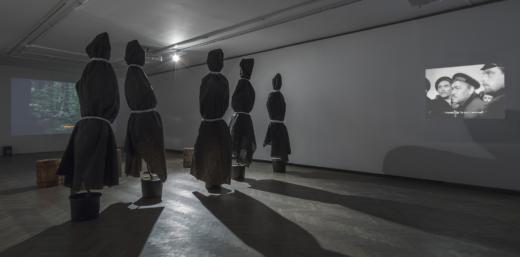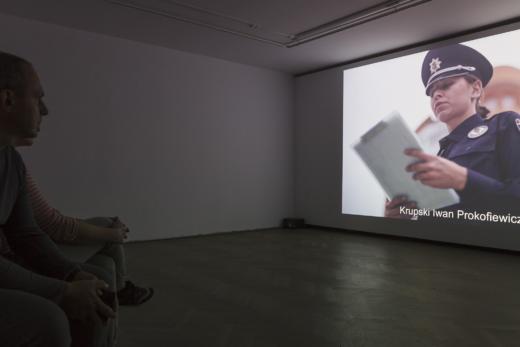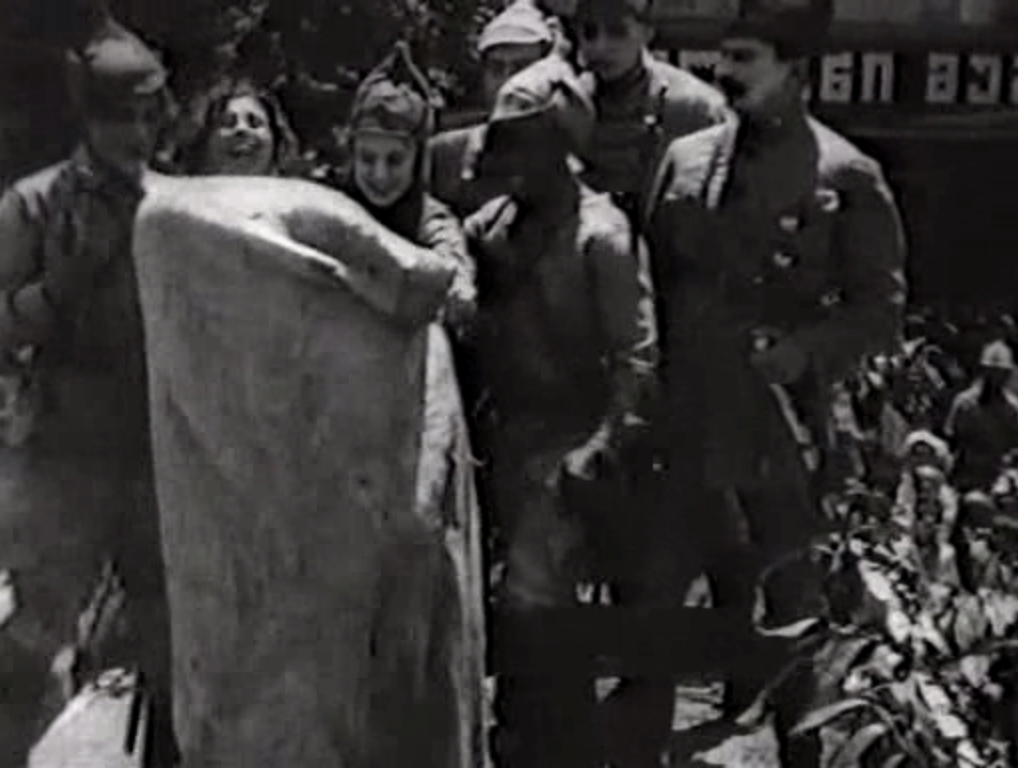Mykola Ridnyi has developed his Wolf in a Sack exhibition around history markers extending beyond material components – such as monuments, films, chopping blocks – into the performative, such as action, storytelling, and customs. The author approaches history by focusing on the contemporary, in recognition of all its complications. Elements of war waged by Russia in Ukraine include i.a. manipulation with the use of olden-day conflicts. Visions of the past, popular and referenced in contemporary political disputes in Ukraine and worldwide, are filled with brutal omissions and interpretations intended to incite social partitioning. Yet history is also widely negotiated today, subject to gradual democratisation as new media develop. People using the past for political jostling apart, history aficionados are now at work as well. More and more individuals with no professional affiliation with the world of historians have been presenting their own story of the past, wishing to be recognised therein.

“Wolf in a Sack”, installation views, photo: Maciej Zaniewski. Courtesy Galeria Arsenal
Acceptance for and understanding of the fact that accounts of events past shall be formed according to specific narrative rules: our knowledge of the past is arranged according to the most frequently applied patterns of storytelling and social perception (obviously affected by the media) – and discrimination symptoms ought to be recognised, attempts made to abate them[1]. Mykola Ridnyi’s Wolf in a Sack exhibition remains close to such perception of history, in all actuality fitting within the category of a fully legitimate historical expression against the background of new humanities, including a recommendation that the author’s position be revealed, while remaining open to intuitive, individual and inimitable implements of art, occasionally difficult to verify.
An anarchist bound
The Wolf in a Sack exhibition references the film medium as its point of departure, supplemented with cinematographic frame-based images and individual objects – steel-rimmed chopping blocks and trees in planting pots – together with copies of investigation paperwork produced in the early days of the USSR.
Ridnyi explores the 1920s – a time of great social turbulence and of ideological and armed struggle for the territory of contemporary Ukraine – with a focus on anarchists. In his quest for an archetype, he has compiled scenes from films about anarchists produced in the USSR over fifty years
Ridnyi explores the 1920s – a time of great social turbulence and of ideological and armed struggle for the territory of contemporary Ukraine – with a focus on anarchists. In his quest for an archetype, he has compiled scenes from films about anarchists produced in the USSR over fifty years: Ivan Perestiani’s Little Red Devils (1923), Leonid Lukov’s Aleksandr Parkhomenka (1942), Samson Samsonov’s Optimistic Tragedy (1963), and – last but not least – Aleksandr Mitta’s Shine, Shine, My Star (1970). In doing so, he has identified a rather absurd leitmotiv: an anarchist is always stuffed into a sack. In the Little Red Devils, for example, Nestor Makhno allows himself to be misled by two teenagers and an African American, all wearing Budenovka hats.
Yes indeed: let me reiterate that a Soviet 1923 film features a young girl, young boy, and an African American as victorious protagonists. The same picture presents appreciation-targeting actions intended to provide equal opportunities to depreciated communities – something we could also applaud today – while depriving other groups of empowerment. Makhno, leader of an autonomous grassroot movement, creator of the anarchist Huliajpole Republic, effective defeater of bolsheviks and followers of Anton Denikin and Symon Petlura at assorted times and in assorted situations, commander of an army of 100,000 at the peak of his strength – is captured and stuffed into a sack by the valiant threesome. Deprived of strength, awe, and dignity. In his sack, he is less than a prisoner: he loses his humanity. A sack may be whacked till dust flies. It’s simply hilarious when the sack shoots.
let me reiterate that a Soviet 1923 film features a young girl, young boy, and an African American as victorious protagonists. The same picture presents appreciation-targeting actions intended to provide equal opportunities to depreciated communities – something we could also applaud today – while depriving other groups of empowerment
The motif of neutralising an anarchist with the use of a sack passes from one film to another, undergoing slight modification in the 1970s. In Shine, Shine, My Star, anarchists intending to shoot the public (noble-hearted peasants who had unquestioningly handed their entire assets over to the kolkhoz) from the stage of a theatre housed by an atheised Orthodox church are collectively captured into the theatre curtain doubling up as a bag. The switch from the sack to the curtain ties in with a change in the array of daily use objects. While the sack was no longer such an item, it continued to be used to the purpose of neutralising anarchists.
Who remembers anarchists today for having taken Hadyach from the bolsheviks?
Grey Horses, a film shot by Ridnyi in 2016, triggered interest and heated debates in Ukraine, having depicted contemporary anarchists. It was shown i.a. at Docudays UA, a popular film festival in Kyiv. In Poland, it was screened at Facing the Wall (2018), an exhibition held at the Galeria Labirynt in Lublin. The film is based on the turbulent history of Ridnyi’s great-grandfather Ivan Krupskyi, a little-known anarchist active in central Ukraine. Historians mention him in connection with bolsheviks having been chased out of Hadyach. The artist gained access to hearing testimonies – documents produced against his ancestor, requiring largely sceptical reading. In a quest for an additional connection to his great-grandfather, Ridnyi invited contemporary anarchists and militia officers from Kharkiv to join the film production; the artist’s forebear had also been a militia officer for a short time, having assumed a false identity.

“Wolf in a Sack”, installation views, photo: Maciej Zaniewski. Courtesy Galeria Arsenal
Ridnyi avoids any beautification measures in film; his works convey the roughness of his daily environment. He wishes to access an anarchist and militia officer of times over one hundred years gone by observing people in such roles today – as if examining a footprint left by a set of similar beliefs or tasks upon a specific group of individuals. While the young anarchists and militia officers playing in Grey Horses are Ridnyi’s great-grandfather’s age, their emotions, actions and choices have been formed by different circumstances altogether. It goes without saying that they had not been exposed to the training in violence known to people living a hundred years ago. Today’s anarchists use dynamic language, as if light-heartedly borrowed from the past to describe the current situation (“oppression of the working class”, “imposition of concepts alien to the working class, such as patriotism or ethnicity”); yet the are ostensibly gentle and resigned. Their short-term and effectively implemented objectives included i.a. the provision of shelter and assistance to refugees from the Crimea and Donbass.
The artist gained access to hearing testimonies – documents produced against his ancestor, requiring largely sceptical reading. In a quest for an additional connection to his great-grandfather, Ridnyi invited contemporary anarchists and militia officers from Kharkiv to join the film production; the artist’s forebear had also been a militia officer for a short time, having assumed a false identity.
They failed to gather a larger group of followers – even the few who responded, dispersed. There were no anarchist youth among workers protesting against the closure of one of the largest industrial plants in Kharkiv. Interestingly, the Grey Horses script includes a dream of a beating. Torturers capture an anarchist in his sleep and beat him up entangled in his duvet, which closely resembles a sack.
De-communisation needed
When talking to journalist Natalia Humeniuk about Grey Horses, the artist says he is outraged by the way de-communisation has been handled in Ukraine in the wake of the 2015 De-Communisation Law. Actual action only involved the removal of communist ideology remnants from public space, whereas practical effects comprised the destruction of gauche communist images as well as cultural heritage; Ukrainian contribution to avant-garde art and local specificity has been annihilated. Many of the destroyed monuments included high-class sculptures which should have been de-heroised rather than demolished; they ought to have been fitted with plaques containing information on the ideological and propaganda circumstances accompanying their creation, which would have been conducive to greater awareness in reception. Following the downfall of the USSR, all related monuments lost their political importance, regaining it only once so-called anti-Maidanists and separatists (supporters of an option blending in nostalgia for a fallen empire with pro-Russian preferences) began referencing them in their own narrative. Yet succumbing to Russia, a party active in appropriating and distorting the future, also spells the abandonment of meaningful historical experience. Ridnyi claims that Ukraine would need contemplation of the long-term effects of early 20th century social movements, abandonment of the tendency to brand all revolution with the all-too-easy to interpret mark of Russian colonisation-focused aggression, and recovery of avant-garde empowerment. The artist further accentuates that opinions concerning the past have become overly simplified.[2]
Ridnyi claims that Ukraine would need contemplation of the long-term effects of early 20th century social movements, abandonment of the tendency to brand all revolution with the all-too-easy to interpret mark of Russian colonisation-focused aggression, and recovery of avant-garde empowerment. The artist further accentuates that opinions concerning the past have become overly simplified
The exhibition section based on Boris Tiahno’s expressionist film The Guardian of the Museum explores strategies of handling unwanted legacy. The film was made in Odessa in 1930, towards the end of the korienizatsyia period – a policy of supporting national cultures repressed under the tsar; USSR territories would soon witness ruthless russification, including regular mass murders of national culture creators. The Guardian of the Museum is a silent film intended to prove the unquestioned superiority of bolshevism over any other belief. A science-loving director of a Museum of Ukrainian Culture chooses to stay away from politics, extending no warm welcome to a red (bolshevik) commissar seconded as a guardian of the institution. Yet he ultimately comes to a propaganda-supporting conclusion that revolution sustains culture. The film comprises a number of tropes in the context of Ukrainian de-communisation debates. Under the commissar’s lead, Red Army soldiers carry monuments to tsars to the museum – Egyptian sarcophagi are flanked by sections of sculptures depicting Nicholas III (recognisable as the Muscovite monument to the tsar demolished by bolsheviks), Catherine II the Great, and Peter I. Tiahno enforces the thesis of museifying rather than destroying. If monuments disappear, reflections concerning their functioning and purpose will be restricted to a narrow circle of enthusiasts, whereas future propagandists – may they never come – will find it easier to use the same ploys.
The film is supplemented by a series of works created on basis of frames from The Guardian of the Museum. The artist removed everything from the frames, leaving only artwork representations, frequently deprived of their original context. The process of reconstructing and constructing meanings takes on the occasional unexpected turn – the famous Marxist phrase describing religion as the opium of the people has been paraphrased by a Red Army soldier: touching a sculpture of an ancient goddess, he sighs, “That kind of opium I understand all too well…”
No pedestal
Mykola Ridnyi reveals his position. The gesture by no means easy. Documents suggest his great-grandfather was responsible for the death of at least four people, their names mentioned in the film Grey Horses. Yet the artist intends to make his ancestor’s story neither tragic nor overtly simple. He takes an identical stance towards his country’s past. He becomes involved on a number of levels: the individual – by choosing his own family’s history as the point of departure; the local – by exploring culture associated with Kharkiv and local conflicts of the early 20th and 21st century; the communal – by inviting contemporary anarchists and militia officers to join the project; and, primarily, the artistic – by dressing his beliefs in art rather than persuasion. His works are incomplete, far from non-ambiguity or assessment. They carry political weight as well as a significant message: problems one-hundred-year-old utopias had responded to have evolved rather than disappeared, and beautifying the past will not help resolve them.
English translation from the Polish language by Aleksandra Sobczak-Kövesi
[1] Cf. Krzysztof Pomian, Historia – dziś (History – Today), in: Historia – dziś. Teoretyczne problemy wiedzy o przeszłości (History – Today, Theoretical Problems of Knowledge of the Past), ed. Ewa Domańska, Rafał Strobiecki, Tomasz Wiślicz, Cracow 2014, pp. 19–38.
[2] Художник Микола Рідний про «Сірих коней» – фільм про свого прадіда харківського анархіста [Artist Mykola Ridnyi on Grey Horses – a film about his great-grandfather the anarchist], Natalia Humeniuk, journalist of hromadskie.ua, interviewing Mykola Ridnyi, online: https://www.youtube.com/watch?v=xce1XHlaZ4E [accessed on June 30th 2019]

